Synthesis and propagation of complement C3 by microglia/monocytes in the aging retina
- PMID: 24705166
- PMCID: PMC3976274
- DOI: 10.1371/journal.pone.0093343
Synthesis and propagation of complement C3 by microglia/monocytes in the aging retina
Abstract
Introduction: Complement activation is thought to contribute to the pathogenesis of age-related macular degeneration (AMD), which may be mediated in part by para-inflammatory processes. We aimed to investigate the expression and localization of C3, a crucial component of the complement system, in the retina during the course of aging.
Methods: SD rats were born and reared in low-light conditions, and euthanized at post-natal (P) days 100, 450, or 750. Expression of C3, IBA1, and Ccl- and Cxcl- chemokines was assessed by qPCR, and in situ hybridization. Thickness of the ONL was assessed in retinal sections as a measure of photoreceptor loss, and counts were made of C3-expressing monocytes.
Results: C3 expression increased significantly at P750, and correlated with thinning of the ONL, at P750, and up-regulation of GFAP. In situ hybridization showed that C3 was expressed by microglia/monocytes, mainly from within the retinal vasculature, and occasionally the ONL. The number of C3-expressing microglia increased significantly by P750, and coincided spatiotemporally with thinning of the ONL, and up-regulation of Ccl- and Cxcl- chemokines.
Conclusions: Our data suggest that recruited microglia/monocytes contribute to activation of complement in the aging retina, through local expression of C3 mRNA. C3 expression coincides with age-related thinning of the ONL at P750, although it is unclear whether the C3-expressing monocytes are a cause or consequence. These findings provide evidence of activation of complement during natural aging, and may have relevance to cellular events underling the pathogenesis of age-related retinal diseases.
Conflict of interest statement
Figures
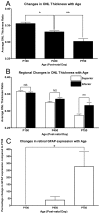

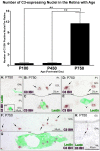
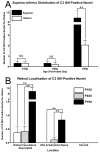

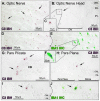
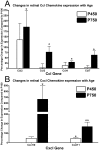
Similar articles
-
670-nm light treatment reduces complement propagation following retinal degeneration.J Neuroinflammation. 2012 Nov 26;9:257. doi: 10.1186/1742-2094-9-257. J Neuroinflammation. 2012. PMID: 23181358 Free PMC article.
-
Analysis of complement expression in light-induced retinal degeneration: synthesis and deposition of C3 by microglia/macrophages is associated with focal photoreceptor degeneration.Invest Ophthalmol Vis Sci. 2011 Jul 18;52(8):5347-58. doi: 10.1167/iovs.10-7119. Invest Ophthalmol Vis Sci. 2011. PMID: 21571681
-
Retinal Macrophages Synthesize C3 and Activate Complement in AMD and in Models of Focal Retinal Degeneration.Invest Ophthalmol Vis Sci. 2017 Jun 1;58(7):2977-2990. doi: 10.1167/iovs.17-21672. Invest Ophthalmol Vis Sci. 2017. PMID: 28605809
-
Para-inflammation in the aging retina.Prog Retin Eye Res. 2009 Sep;28(5):348-68. doi: 10.1016/j.preteyeres.2009.06.001. Epub 2009 Jun 26. Prog Retin Eye Res. 2009. PMID: 19560552 Review.
-
Targeting complement components C3 and C5 for the retina: Key concepts and lingering questions.Prog Retin Eye Res. 2021 Jul;83:100936. doi: 10.1016/j.preteyeres.2020.100936. Epub 2020 Dec 13. Prog Retin Eye Res. 2021. PMID: 33321207 Free PMC article. Review.
Cited by
-
Abnormal Complement Activation and Inflammation in the Pathogenesis of Retinopathy of Prematurity.Front Immunol. 2017 Dec 22;8:1868. doi: 10.3389/fimmu.2017.01868. eCollection 2017. Front Immunol. 2017. PMID: 29312345 Free PMC article.
-
Fecal microbiota transfer between young and aged mice reverses hallmarks of the aging gut, eye, and brain.Microbiome. 2022 Apr 29;10(1):68. doi: 10.1186/s40168-022-01243-w. Microbiome. 2022. PMID: 35501923 Free PMC article.
-
Subretinal macrophages produce classical complement activator C1q leading to the progression of focal retinal degeneration.Mol Neurodegener. 2018 Aug 20;13(1):45. doi: 10.1186/s13024-018-0278-0. Mol Neurodegener. 2018. PMID: 30126455 Free PMC article.
-
C3- and CR3-dependent microglial clearance protects photoreceptors in retinitis pigmentosa.J Exp Med. 2019 Aug 5;216(8):1925-1943. doi: 10.1084/jem.20190009. Epub 2019 Jun 17. J Exp Med. 2019. PMID: 31209071 Free PMC article.
-
Moss-derived human complement factor H modulates retinal immune response and attenuates retinal degeneration.J Neuroinflammation. 2025 Apr 11;22(1):104. doi: 10.1186/s12974-025-03418-2. J Neuroinflammation. 2025. PMID: 40217267 Free PMC article.
References
-
- Bonnel S, Mohand-Said S, Sahel JA (2003) The aging of the retina. Exp Gerontol 38: 825–831. - PubMed
-
- Ambati J, Ambati BK, Yoo SH, Ianchulev S, Adamis AP (2003) Age-related macular degeneration: etiology, pathogenesis, and therapeutic strategies. Surv Ophthalmol 48: 257–293. - PubMed
-
- Rein DB, Wittenborn JS, Zhang X, Honeycutt AA, Lesesne SB, et al. (2009) Forecasting age-related macular degeneration through the year 2050: the potential impact of new treatments. Arch Ophthalmol 127: 533–540. - PubMed
Publication types
MeSH terms
Substances
LinkOut - more resources
Full Text Sources
Other Literature Sources
Medical
Miscellaneous

